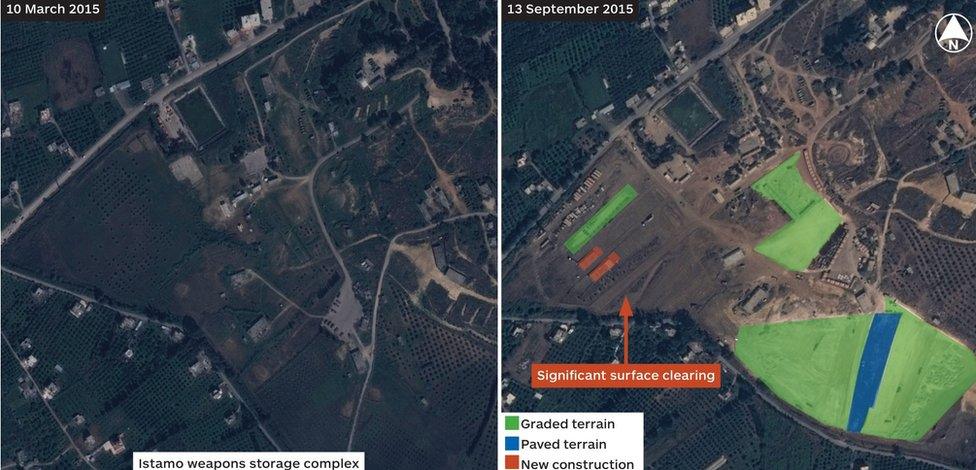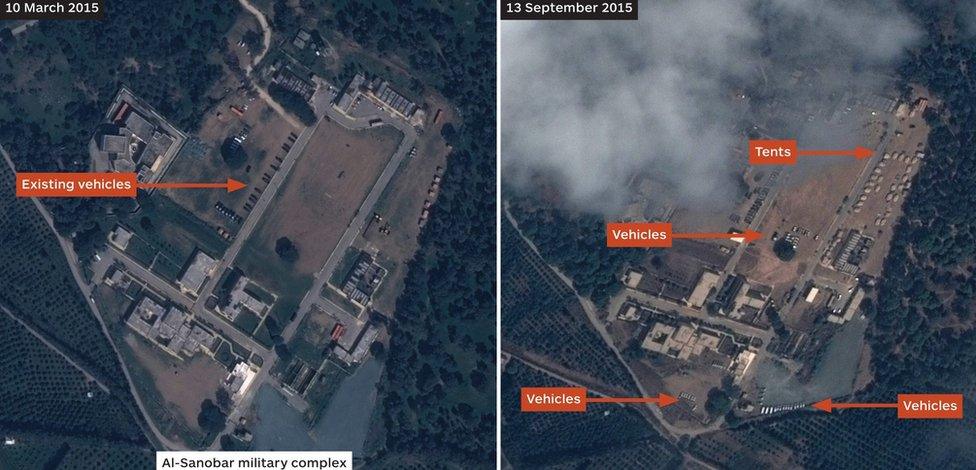Russia's Syria military build-up is self-protection - Kerry
- Published

John Kerry has urged Russia to help bring the Syrian conflict to an end
Russia's military build-up in Syria appears to be limited to protecting its own forces in the country, US Secretary of State John Kerry has said.
However, Mr Kerry warned that Russia's long-term intentions remained unclear.
His comments on Tuesday followed the publication of satellite images that suggested Russia was developing two additional military bases in Syria.
The images show new buildings, surface clearing and tents at a weapons depot and military complex north of Latakia.

It had been thought the Russian build-up was centred on the Mediterranean port city's international airport, to the south, where dozens of warplanes and attack helicopters have arrived in recent weeks.
Tanks, anti-aircraft systems, drones and 200 marines have also reportedly been sent, along with housing for up to 2,000 personnel.
But the new satellite images from mid-September, published by defence research group IHS Jane's, appear to show preparations are under way to receive Russian forces at the Istamo weapons depot and the al-Sanobar military complex.

Analysis: Jonathan Marcus, diplomatic correspondent, BBC News
The latest satellite photos provide even more evidence of Russia's growing military deployment to Syria but very few answers to the question, what is it all for?
US Secretary of State John Kerry's characterisation of the Russian posture as intended for self-defence may be an effort to reduce tensions, but again gets us no further as to Moscow's motives.
What is clear is that a sizeable air expeditionary force has been sent to the airbase at Latakia, including about 24 ground-attack aircraft and a small number of multi-role fighters. There are attack helicopters too and drones, along with the various additional ground elements needed to defend the base against attack.
But the new evidence from IHS Jane's suggests preparations at at least two bases for the arrival of a significant number of Russian ground troops. So the questions remain: is this simply a demonstration to bolster Mr Assad? Is it essentially military theatre to emphasise Russia's role in any diplomatic effort? Or are we seeing the preparations for a Russian intervention in the fighting?
What's at stake for Russia in Syria?

"This activity includes the construction of new buildings, significant surface clearing, the grading and paving of terrain, and the presence of tents of the same type as those used by Russian military units," Robert Munks, editor of IHS Jane's Intelligence Review, told the AFP news agency.
Russian Defence Minister Sergei Shoigu assured US Defence Secretary Ashton Carter in a telephone call on Friday that the deployment was "defensive in nature" and focused on protecting the Russian naval facility at Tartous, south of Latakia.

However, the arrival of the Russian warplanes raised concerns that Moscow was preparing to intervene directly to shore up President Assad, whose forces have suffered a series of defeats to rebel forces and jihadist militants from Islamic State (IS) this year.
"For the moment, it is the judgement of our military and experts that the level and type represents basically force protection," Mr Kerry told reporters on Tuesday.
But he said that Russia's longer-term intentions remained unclear and called on Russian President Vladimir Putin to support international efforts to end the Syrian conflict.
"If [Russia is] there to shore up Assad and to certainly provide Assad with the continued sense he doesn't have to negotiate, then I think it's a problem for Syria, and it's a problem for everybody who wants to bring an end to this conflict, which has gone on for too long," he added.
UN-led peace talks on Syria have failed to bring the opposing sides together to agree on a transitional government body that would take over from Mr Assad.
Mr Kerry will meet counterparts from Europe and the Middle East on the sidelines of the UN General Assembly next week to discuss solutions to the conflict.